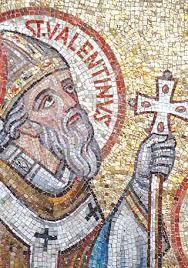What’s Better Than Feeling Love in Your Life?
Sharing IT with Others!
Love is a many splendored thing… as they say.
IT can be wonder lust, or it can also be confusing with mixed messages, leaving some hurtful and jealous!
Love and Valentine’s Day are both an ongoing fascination and a mystery in our brief collection of human history.
First, let me give you a lowdown on the most recent history of Valentines and how it moved into the modern age as one of our biggest commercial holiday celebrations.
Down the page, readers will find some excellent detailed history on the Martyr St. Valentine, plus a video link from History Channel.
So it all started with crazy church parties, the tradition was Roman’s would whip young women with strips of meat to increase fertility… Ok, is this weird, or what?
Starting sometime around the third century, their was about a dozen or so Valentine guys. In about 500 AD the Pope at the time canonized a St. Valentine. And there you have IT!
The Valentine Card tradition is interesting. Apparently, a jailed St. Valentine fell in love with his jailors daughter. On the day of his execution, he passed a note to his love interest that was signed, “From Your Valentine.” Kind of a happy, sad, the game is now over – Love Story?
Cupid was connected to the Roman God of Love, the Catholic church added the cherub angels into the action between the 1300 and 1700’s. About 1840 the Valentine Card became an American tradition that has spread the word of Love around the world in many languages.
Now that Valentine’s Day is recognized outside of the religious context, it has become on of the biggest and most celebrated days on our calendars.
About 62% of Americans will be celebrating Valentines, but not always together 🙁 This is a huge time of giving and sending gifts to that special someone…
Valentine Consumer Statistics include; Approximately 200+ million in roses (red), 36 million heart shaped boxes of candy, plus millions of cards dinners and diamonds!
As you can imagine, many people choose Valentine’s as the day to pop that big question. So if it’s not diamonds this year, there are still millions of gold hearts to be awarded.
Add it all up and the spending for Valentine’s Day will go over $14 Billion, that’s an average spend of about $130 per year per person…
But hey – All You Need is Love 🙂
1. The St. Valentine who inspired the holiday may have been two different men.
Officially recognized by the Roman Catholic Church, St. Valentine is known to be a real person who died around A.D. 270. However, his true identity was questioned as early as A.D. 496 by Pope Gelasius I, who referred to the martyr and his acts as “being known only to God.” One account from the 1400s describes Valentine as a temple priest who was beheaded near Rome by the emperor Claudius II for helping Christian couples wed. A different account claims Valentine was the Bishop of Terni, also martyred by Claudius II on the outskirts of Rome. Because of the similarities of these accounts, it’s thought they may refer to the same person. Enough confusion surrounds the true identity of St. Valentine that the Catholic Church discontinued liturgical veneration of him in 1969, though his name remains on its list of officially recognized saints.
2. In all, there are about a dozen St. Valentines, plus a pope.
The saint we celebrate on Valentine’s Day is known officially as St. Valentine of Rome in order to differentiate him from the dozen or so other Valentines on the list. Because “Valentinus”—from the Latin word for worthy, strong or powerful—was a popular moniker between the second and eighth centuries A.D., several martyrs over the centuries have carried this name. The official Roman Catholic roster of saints shows about a dozen who were named Valentine or some variation thereof. The most recently beatified Valentine is St. Valentine Berrio-Ochoa, a Spaniard of the Dominican order who traveled to Vietnam, where he served as bishop until his beheading in 1861. Pope John Paul II canonized Berrio-Ochoa in 1988. There was even a Pope Valentine, though little is known about him except that he served a mere 40 days around A.D. 827.
3. Valentine is the patron saint of beekeepers and epilepsy, among many other things.
Saints are certainly expected to keep busy in the afterlife. Their holy duties include interceding in earthly affairs and entertaining petitions from living souls. In this respect, St. Valentine has wide-ranging spiritual responsibilities. People call on him to watch over the lives of lovers, of course, but also for interventions regarding beekeeping and epilepsy, as well as the plague, fainting and traveling. As you might expect, he’s also the patron saint of engaged couples and happy marriages.
4. You can find Valentine’s skull in Rome.
The flower-adorned skull of St. Valentine is on display in the Basilica of Santa Maria in Cosmedin, Rome. In the early 1800s, the excavation of a catacomb near Rome yielded skeletal remains and other relics now associated with St. Valentine. As is customary, these bits and pieces of the late saint’s body have subsequently been distributed to reliquaries around the world. You’ll find other bits of St. Valentine’s skeleton on display in the Czech Republic, Ireland, Scotland, England and France.
5. Chaucer may have invented Valentine’s Day.
The medieval English poet Geoffrey Chaucer often took liberties with history, placing his poetic characters into fictitious historical contexts that he represented as real. No record exists of romantic celebrations on Valentine’s Day prior to a poem Chaucer wrote around 1375. In his work “Parliament of Foules,” he links a tradition of courtly love with the celebration of St. Valentine’s feast day–an association that didn’t exist until after his poem received widespread attention. The poem refers to February 14 as the day birds (and humans) come together to find a mate. When Chaucer wrote, “For this was sent on Sent Valentine’s day / When every foul cometh there to choose his mate,” he may have invented the holiday we know today.
6. You can celebrate Valentine’s Day several times a year.
Because of the abundance of St. Valentines on the Roman Catholic roster, you can choose to celebrate the saint multiple times each year. Besides February 14, you might decide to celebrate St. Valentine of Viterbo on November 3. Or maybe you want to get a jump on the traditional Valentine celebration by feting St. Valentine of Raetia on January 7. Women might choose to honor the only female St. Valentine (Valentina), a virgin martyred in Palestine on July 25, A.D. 308. The Eastern Orthodox Church officially celebrates St. Valentine twice, once as an elder of the church on July 6 and once as a martyr on July 30.
Find more history and interesting facts about Valentine’s Day click to view at the History Channel: www.history.com/topics/valentienes-day



Leave a Reply